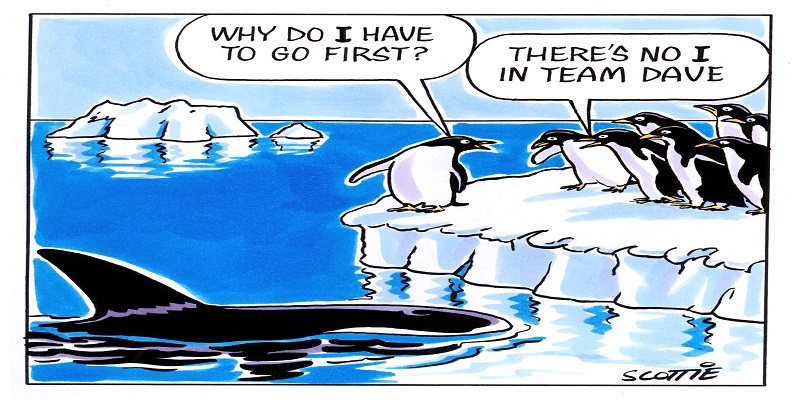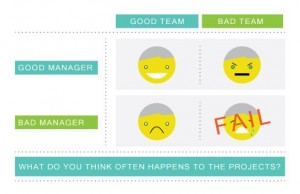5 Ways to achieve Team Success

Today we will chat about project and team success rates and the choices we can make at the onset of a task or tasks to ensure success. We rarely do tasks alone, and a team needs to be actively managed toward successful completion of tasks. (Please see Creating Great Teams and Volunteering.) When volunteers are involved, you must accomplish this carefully and purposefully. You need to be ready to make choices along the way for each project and understand what the consequences will be.
Figure 1 shows a team/manager matrix making poor choices (or no choices). There are four possible outcomes for a particular objective or task in this simple analysis. We can assume that a bad team or a bad leader can lead to a difficult or unsuccessful task. One negative can make a quadrant’s scenario difficult at best. Thus, there is just one quadrant, or one out of four of these team dynamic scenarios in which we will not have potential problems. Ouch—this is not a good way to initiate any sort of worthwhile task or project.

Figure 1 – Team / Manager Matrix Making Poor / No Choices
If we take this a bit farther and assign a probability to each quadrant of 25%, we can also see from the matrix that teams can expect that 50% of their tasks will have troublesome issues prior to the start and 25% are ready for the grave before they even begin. When there is a bad team and a bad manager, we can expect that any given task may be a disaster. Can we live with this result? We do not think so.
A lack of team understanding and team management skills, coupled with bad “Choice” attitudes will hinder tasks from being successful. In fact, the difficult scenarios may even rub off poison on other folks in the organization who are trying to “Do Good.”
We cannot emphasize enough the importance of healthy teams and healthy team choices.
How do we personally change the above paradigm? We make healthy and positive choices without regard to where others may lay on the graphic.
1. We need to eliminate posturing and politics and choose to make positive contributions despite where we may find ourselves beginning.
2. We must set aside and ignore our individual issues, any blaming that may be taking place, and the lack of personal responsibility by other members of the team.
3. We need to choose to have a good attitude and thus choose to start a task with the best foot forward to help all find success. We do this in part by making sure we are always backing up the person on the team who just doesn’t get it, or who perhaps has a bad attitude that cannot be fixed in the short run. We work around them, over them, or despite them, and we do not let the negative ruin our good volunteering day.
4. We need to have patience with others in all we do. Count—then re-act.
5.We must keep our focus on the objectives—work issues and not personalities. Find a way to “Win”.
These are all contributing choices. We must always keep our objectives in mind and maintain a positive, patient and forward-looking attitude.
Don’t forget to read Part II of this article next week.
About the author: Karl’s volunteer management experience spans three decades. He recently retired as a chief strategy officer, after having implemented the strategic plan of a 1500+ employee service sector organization. He has taught courses in management, business and economics, operations research, and project management. He holds degrees in engineering and economics and is near completion of a second book on the management of highly competitive environments. His initial volunteering experience involved the management of a food buying co-op while an undergraduate. Recently he has provided strategic planning, project management and technical assistance to numerous volunteer organizations and communities and has written extensively on the subject. Karl resides in the Missouri Ozarks and can be reached at kburgher@SunshineValley.org.




